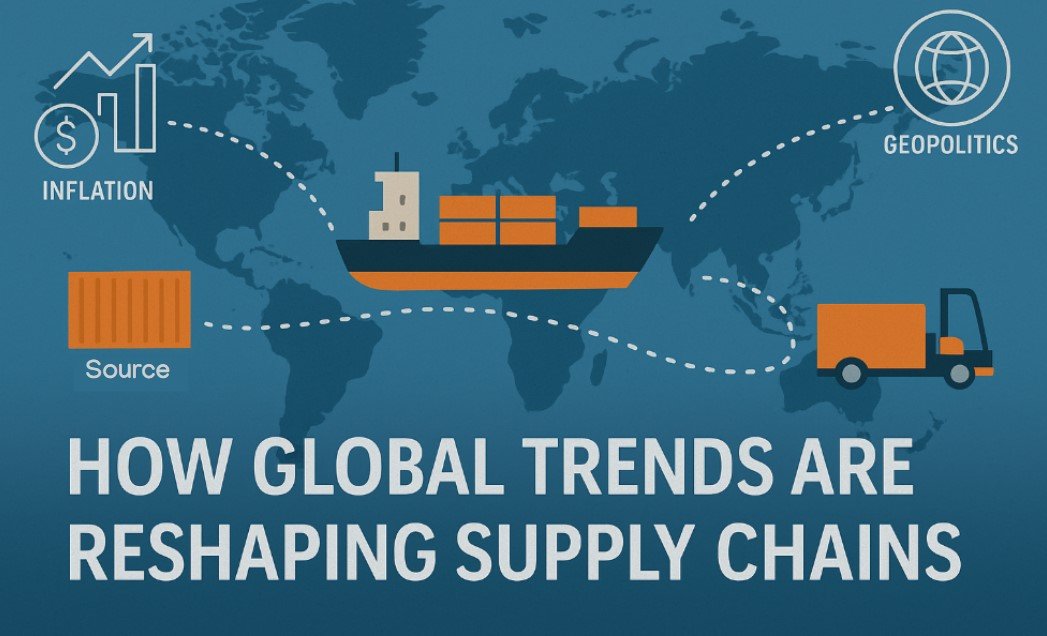Business
How Global Trends Are Reshaping Supply Chains

In today’s rapidly shifting business landscape, global supply chains are under immense pressure to adapt, transform, and become more resilient. From geopolitical shifts and technological innovations to climate change and evolving consumer expectations, supply chains are being redefined at every level. Organizations are being forced to rethink their logistics, sourcing, and operational strategies to remain competitive and sustainable.
Introduction to Supply Chain Management
Supply chain management (SCM) is defined as the planning and management of activities undertaken to produce and deliver a product or service from raw materials to end consumers. It includes procurement, manufacturing, warehousing, logistics, and distribution. The procurement phase of this process can be significantly optimized with purchase requisition software that provides visibility into spending requests, enforces approval workflows, and ensures all purchases align with budgetary constraints before orders are placed.
Over the last few years, SCM has moved away from being a purely operational function to a strategic field. Companies are now smarter about realizing that good supply chain management can be a potent competitive advantage. In today’s world, interconnected global markets are accompanied by expectations of customers, and therefore, the necessity of agility and foresight when dealing with the supply chains has become a fact.
To keep pace with these changes, professionals are turning to structured learning through a supply chain management course to gain insights into the latest tools, strategies, and global practices. These courses help build foundational knowledge and develop skills needed to navigate complex supply chain challenges.
How Is Technology Reshaping the Modern Supply Chain?
Technology is a primary driver of transformation in supply chain management. Innovations such as artificial intelligence (AI), machine learning, blockchain, and the Internet of Things (IoT) are changing how supply chains operate.
- Automation and AI: Robotics and AI-powered systems are being used to automate warehousing, inventory tracking, and transportation. These technologies enhance efficiency, minimize errors, and allow real-time decision-making.
- Blockchain: Blockchain allows for open, secure transactions, which enable companies to track the origin and movement of goods. This is particularly beneficial for industries like pharmaceuticals and food, where traceability is very important.
- IoT and Real-Time Tracking: IoT sensors provide real-time data on shipments, helping businesses optimize routes and reduce delays. Predictive analytics further allows companies to anticipate disruptions and plan accordingly.
- Cloud Computing and ERP Systems: These tools facilitate better partnership among different stakeholders in the supply chain, provide centralized access to data, and improve communication across geographies.
As technology continues to transform, companies that leverage these innovations will be able to handle uncertainties and meet growing customer demands efficiently.
What Is the Current Trend in Global Supply Chain Management?
Global supply chain management is being influenced by several significant trends, many of which have accelerated in recent years:
1. Resilience and Risk Management
Recent disruptions, such as the COVID-19 pandemic and geopolitical tensions, have highlighted the drawbacks of global supply chains. Because of this, businesses are prioritizing resilience through supplier diversification, nearshoring, and buffer inventories.
2. Sustainability and Green Logistics
Environmental issues pressure organizations to use sustainable practices. These involve using green packaging, efficient transportation that reduces greenhouse gas emissions, and responsible ethical sourcing. The ability to be sustainable is now a critical performance metric in global supply chain strategies.
3. Digital Supply Chains
Shift in the trajectory of digital supply chains from traditional is encouraging firms to run with more transparency and agility. The digital twins, for instance, enable the firms to build virtual copies of their supply networks to perform better forecasting and planning.
4. Customization and Customer-Centric Models
Modern supply chains are becoming more customer-centric. Companies are making use of the data to gain more knowledge about consumer behavior and tailor logistics to meet specific needs, such as same-day delivery or personalized packaging.
5. Compliance and Regulation
As supply chains extend across borders, navigating regulatory frameworks has become increasingly complex. Companies must stay updated with import/export laws, labor regulations, and environmental policies in different countries.
These trends are reshaping how organizations design, manage, and evaluate their global supply chains, prompting a strategic shift toward more agile and responsive systems.
How Will Globalization Impact the Future of Supply Chain Management?
Globalization has long been a catalyst for supply chain expansion, offering businesses access to broader markets and lower production costs. However, the nature of globalization is evolving, and its impact on supply chain management is becoming more nuanced.
- Shift Toward Regionalization: Due to geopolitical instability, trade wars, and the pandemic, companies are reconsidering global dependencies. There’s a growing trend toward regionalization, where businesses build supply networks closer to the end markets to reduce risk and improve responsiveness.
- Increased Supply Chain Complexity: Operating across multiple countries introduces logistical and regulatory complexities. Managing cross-border operations now requires more advanced coordination, legal compliance, and risk management strategies.
- Workforce Globalization: The supply chain workforce is also becoming more global, necessitating training and development programs that address diverse operational contexts and cultural considerations.
- Global Collaboration and Innovation: Although disturbing, globalization still engenders collaboration and innovation. Multinational supply networks can harvest state-of-the-art technological innovations and best practices from across the world and develop cheaper and more efficient systems.
Overall, while globalization presents challenges, it also offers new opportunities for supply chain evolution and strategic growth.
Conclusion
As global trends continue to shape and reshape the landscape of supply chain management, adaptability and innovation have become critical to success. Technology, sustainability, risk management, and globalization are not just external influences but integral components of modern supply chain strategy. Organizations must invest in the tools, talent, and knowledge necessary to navigate these shifts effectively.
Building this knowledge often starts with education. Programs such as the IIM Supply Chain Management course provide professionals with deep insights into global supply chain practices, technological integration, and strategic thinking. As supply chains become more complex and interconnected, having a strong foundation in these areas is essential to drive long-term value and resilience.
By understanding and adapting to the ongoing global trends, businesses can not only survive disruptions but thrive in an increasingly dynamic and interconnected world.
-

 Tech2 months ago
Tech2 months agoSora 2 Invite Code: How to Get One (Step-by-Step Guide)
-

 Social Media2 months ago
Social Media2 months agoWhat the “67” TikTok Meme Really Means
-

 Business2 months ago
Business2 months agoDubai Freezone Company Formation: From Name Reservation to Bank Account
-

 Tech2 months ago
Tech2 months agoWhat To Do When Your Business Faces Network Vulnerabilities






